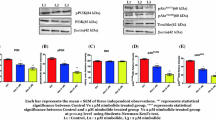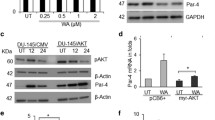Abstract
Purpose
We investigated the action mechanism of a novel anticancer compound, KR28 (1-allyl-4-dodecanoyl-1-ethyl-piperazin-1-ium; bromide), to induce apoptosis of human prostate carcinoma PC-3 cells.
Methods
To explore an apoptotic signaling of KR28, we used ROS assay, SRB assay, flow cytometry analysis, reporter assay, xenograft assay, Western blotting, and RT-PCR analysis.
Results
The growth inhibitory action of KR28 is cell line specific, impeding the growth of prostate carcinoma PC-3 and stomach carcinoma NUGC-3 cells. KR28 showed strong antitumor activity in PC-3 mouse xenograft model. KR28 increased ROS production, leading to nuclear c-Abl expression, which in turn activated p38 mitogen-activated protein kinase (MAPK) to enhance the expression of RhoB, an apoptosis inducer. The KR28-induced apoptosis was abrogated by the ROS scavenger N-acetylcysteine and by knockdown of c-Abl, p38 MAPK, or ATF2. Moreover, the p300 binding site and two CCAAT boxes in the RhoB promoter appear to be involved in ROS-mediated RhoB expression in the presence of KR28.
Conclusion
The antitumor agent KR28 induces apoptosis of PC-3 cells by ROS-mediated RhoB expression via c-Abl upregulation and activation of p38 MAPK/ATF-2.






Similar content being viewed by others
Abbreviations
- ROS:
-
Reactive oxygen species
- NAC:
-
N-acetyl cysteine
- MAPK:
-
Mitogen-activated protein kinase
- SAPK/JNK:
-
Stress-activated protein kinase/c-Jun N-terminal kinase
- PI3K:
-
Phosphoinositide 3-kinase
- FTI:
-
Farnesyltransferase inhibitor
- SRB:
-
Sulforhodamine B
References
Wu WS (2006) The signaling mechanism of ROS in tumor progression. Cancer Metastasis Rev 25:695–705
Pelicano H, Carney D, Huang P (2004) ROS stress in cancer cells and therapeutic implications. Drug Resist Updat 7:97–110
Brandon M, Baldi P, Wallace DC (2006) Mitochondrial mutations in cancer. Oncogene 25:4647–4662
Pan J, She M, Xu ZX, Sun L, Yeung SC (2005) Farnesyltransferase inhibitors induce DNA damage via reactive oxygen species in human cancer cells. Drug Resist Updat 65:3671–3681
Kharbanda S, Ren R, Pandey P, Shafman TD, Feller SM, Weichselbaum RR, Kufe DW (1995) Activation of the c-Abl tyrosine kinase in the stress response to DNA-damaging agents. Nature 376:785–788
Yuan ZM, Huang Y, Whang Y, Sawyers C, Weichselbaum R, Kharbanda S, Kufe D (1996) Role for c-Abl tyrosine kinase in growth arrest response to DNA damage. Nature 382:272–274
Kharbanda S, Yuan ZM, Weichselbaum R, Kufe D (1998) Determination of cell fate by c-Abl activation in the response to DNA damage. Oncogene 17:3309–3318
Kralova J, Dvorak M, Koc M, Kral V (2008) p38 MAPK plays an essential role in apoptosis induced by photoactivation of a novel ethylene glycol porphyrin derivative. Oncogene 27:3010–3020
Scheijen B, Griffin JD (2002) Tyrosine kinase oncogenes in normal hematopoiesis and hematological disease. Oncogene 21:3314–3333
Mazieres J, Antonia T, Daste G, Muro-Cacho C, Berchery D, Tillement V, Pradines A, Sebti S, Favre G (2004) Loss of RhoB expression in human lung cancer progression. Clin Cancer Res 10:2742–2750
Adini I, Rabinovitz I, Sun JF, Prendergast GC, Benjamin LE (2003) RhoB controls Akt trafficking and stage-specific survival of endothelial cells during vascular development. Genes Dev 17:2721–2732
Prendergast GC (2001) Actin’ up: RhoB in cancer and apoptosis. Nat Rev Cancer 1:162–168
Huang M, Prendergast GC (2006) RhoB in cancer suppression. Histol Histopathol 21:213–218
Kim CH, Won M, Choi CH, Ahn J, Kim BK, Song KB, Kang CM, Chung KS (2010) Increase of RhoB in gamma-radiation-induced apoptosis is regulated by c-Jun N-terminal kinase in Jurkat T cells. Biochem Biophys Res Commun 391:1182–1186
Delarue FL, Adnane J, Joshi B, Blaskovich MA, Wang DA, Hawker J, Bizouarn F, Ohkanda J, Zhu K, Hamilton AD et al (2007) Farnesyltransferase and geranylgeranyltransferase I inhibitors upregulate RhoB expression by HDAC1 dissociation, HAT association and histone acetylation of the RhoB promoter. Oncogene 26:633–640
Fritz G, Kaina B (2001) Transcriptional activation of the small GTPase gene rhoB by genotoxic stress is regulated via a CCAAT element. Nucleic Acids Res 29:792–798
Kim BK, Kim HM, Chung KS, Kim DM, Park SK, Song A, Won KJ, Lee K, Oh YK, Lee K et al (2011) Upregulation of RhoB via c-Jun N-terminal kinase signaling induces apoptosis of the human gastric carcinoma NUGC-3 cells treated with NSC12618. Carcinogenesis 32:254–261
Kim BK, Kim DM, Chung KS, Park SK, Choi SJ, Song A, Lee K, Lee CW, Song KB, Han G et al (2011) NSC126188, a piperazine alkyl derivative, induces apoptosis via upregulation of RhoB in HeLa cells. Invest New Drugs 29:853–860
Kim DM, Koo SY, Jeon K, Kim MH, Lee J, Hong CY, Jeong S (2003) Rapid induction of apoptosis by combination of flavopiridol and tumor necrosis factor (TNF)-alpha or TNF-related apoptosis-inducing ligand in human cancer cell lines. Cancer Res 63:621–626
Chung KS, Yim NH, Lee SH, Choi SJ, Hur KS, Hoe KL, Kim DU, Goehle S, Kim HB, Song KB et al (2008) Identification of small molecules inducing apoptosis by cell-based assay using fission yeast deletion mutants. Invest New Drugs 26:299–307
Dignam JD, Lebovitz RM, Roeder RG (1983) Accurate transcription initiation by RNA polymerase II in a soluble extract from isolated mammalian nuclei. Nucleic Acids Res 11:1475–1489
Kim DM, Chung KS, Choi SJ, Jung YJ, Park SK, Han GH, Ha JS, Song KB, Choi NS, Kim HM et al (2009) RhoB induces apoptosis via direct interaction with TNFAIP1 in HeLa cells. Int J Cancer 125:2520–2527
Lee CW, Hong DH, Han SB, Jung SH, Kim HC, Fine RL, Lee SH, Kim HM (2002) A novel stereo-selective sulfonylurea, 1-[1-(4-aminobenzoyl)-2,3-dihydro-1H-indol-6-sulfonyl]-4-phenyl-imidazolidin-2-one, has antitumor efficacy in in vitro and in vivo tumor models. Biochem Pharmacol 64:473–480
Chen LH, Hsu CY, Weng CF (2006) Involvement of P53 and Bax/Bad triggering apoptosis in thioacetamide-induced hepatic epithelial cells. World J Gastroenterol 12:5175–5181
Yang JS, Song D, Lee B, Ko WJ, Park SK, Won M, Lee K, Kim HM, Han G (2011) Synthesis and biological evaluation of novel aliphatic amido-quaternary ammonium salts for anticancer chemotherapy: part I. Euro J Med Chem 46:2861–2866
Kamasani U, Duhadaway JB, Alberts AS, Prendergast GC (2007) mDia function is critical for the cell suicide program triggered by farnesyl transferase inhibition. Cancer Biol Thera 6:1422–1427
Acknowledgments
This work was supported in part by a grant from the 21st Century Frontier for Functional Analysis of the Human Genome (FG09-31-02), from the Ministry of Education, Science and Technology (2010-0025517, 2011-0007275), and the KRIBB Initiative.
Conflict of interest
None.
Author information
Authors and Affiliations
Corresponding author
Additional information
Kyung-Sook Chung, Gyoonhee Han and Bo-Kyung Kim have contributed equally to this work.
Electronic supplementary material
Below is the link to the electronic supplementary material.


Rights and permissions
About this article
Cite this article
Chung, KS., Han, G., Kim, BK. et al. A novel antitumor piperazine alkyl compound causes apoptosis by inducing RhoB expression via ROS-mediated c-Abl/p38 MAPK signaling. Cancer Chemother Pharmacol 72, 1315–1324 (2013). https://doi.org/10.1007/s00280-013-2310-y
Received:
Accepted:
Published:
Issue Date:
DOI: https://doi.org/10.1007/s00280-013-2310-y




